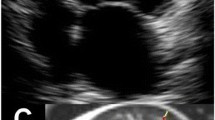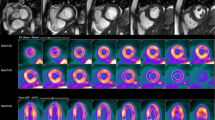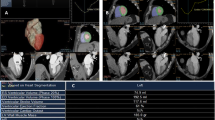Abstract
Left ventricular (LV) mass:volume ratios indexed to body size (Mi/Vi) provide risk stratification for cardiac events. We sought to determine whether Rb-82 PET mass and volume indices are similar to MRI normal values for low likelihood subjects, and whether abnormal indices are related to abnormal myocardial blood flow (MBF). Data were analyzed retrospectively for 194 patients referred for rest/stress Rb-82 PET. LV EF, volume and mass values were calculated and mass:volume ratios were indexed to patients’ height and weight. MBF was computed from the first pass dynamic component of PET data. 53 patients at low likelihood of CAD had PET Mi/Vi = 1.35 ± 0.27, consistent with the MRI literature range of 1.0–1.5. Compared to patients with normal indexed volume (Vi), patients with abnormally high Vi had lower rest MBF (0.56 ± 0.24 vs 0.93 ± 0.57 ml/g/min, p = 0.0001), and lower stress MBF (0.97 ± 0.52 vs. 1.83 ± 0.96 ml/g/min, p < 0.0001). Stress EF < 50% predicted abnormal Vi with 90% accuracy. Patients with Mi/Vi < 1.0 had abnormally low rest EF (45 ± 16% vs. 60 ± 15%, p < 0.0001) and low rest MBF (0.58 ± 0.25 vs. 0.96 ± 0.59 ml/g/min, p < 0.0001). In our study population, abnormal LV volume and mass correlated with lower rest and stress MBF and EF, suggesting that the pathophysiologic explanation of these patients’ increased risk is more extensive obstructive CAD.




Similar content being viewed by others
References
Hsiao E, Bilal A, Blankstein R et al (2013) Detection of obstructive coronary artery disease using regadenoson stress and 82Rb PET/CT myocardial perfusion imaging. J Nucl Med 54:1748–1754
Parkash R, deKemp RA, Ruddy TD et al (2004) Potential utility of rubidium 82 PET quantification in patients with 3-vessel coronary artery disease. J Nucl Cardiol 11:440–449
Johnson N, Tóth GG, Lai D et al (2014) Prognostic value of fractional flow reserve. Linking physiologic severity to clinical outcomes. J Am Coll Cardiol 64:1641–1654
Schindler TH, Quercioli A, Valenta I, Ambrosio G, Wahl RL, Dilsizian V (2014) Quantitative assessment of myocardial blood flow—clinical and research applications. Semin Nucl Med 44:274–293
Prior JO, Allenbach G, Valenta I et al (2012) Quantification of myocardial blood flow with 82Rb positron emission tomography: clinical validation with 15O-water. Eur J Nucl Med Mol Imaging 39:1037–1047
Dorbala S, Hachamovitch R, Curillova Z et al (2009) Incremental prognostic value of gated Rb-82 positron emission tomography myocardial perfusion imaging over clinical variables and rest LVEF. JACC Cardiovasc Imaging 2:846–854
Van Tosh A, Reichek N, Phippen-Nater B, Palestro CJ, Nichols KJ (2014) Consistency of myocardial mass computations as a quality control check on rest and stress left ventricular ejection fractions computed from Rb-82 PET data. Clin Nucl Med 39:593–597
Dewey FE, Rosenthal D, Murphy DJ Jr, Froelicher VF, Ashley EA (2008) Does size matter? Clinical applications of scaling cardiac size and function for body size. Circulation 117:2279–2287
Bluemke DA, Kronmal RA, Lima JAC et al (2008) The relationship of left ventricular mass and geometry to incident cardiovascular events: The MESA (multi-ethnic study of atherosclerosis) study. J Am Coll Cardiol 52:2148–2155
Boyd HL, Gunn RN, et al (1996) Non-invasive measurement of left ventricular volumes and function by gated positron emission tomography. Eur J Nucl Med 23:1594–1602
Boyd H, Rosen SD, Rimoldi O, Cunningham V, Camici PG (1998) Normal values for left ventricular volumes obtained using gated PET. G Ital Cardiol 28:1207–1214
Rajappan K, Livieratos L, Camici PG, Pennell DJ (2002) Measurement of ventricular volumes and function: a comparison of gated PET and cardiovascular magnetic resonance. J Nucl Med 43:806–810
Dorbala S, Di Carli MF, Delbeke D et al (2013) SNMMI/ASNC/SCCT guideline for cardiac SPECT/CT and PET/CT 1.0. J Nucl Med 54:1485–1507
Bravo PE, Pozios I, Pinheiro A et al (2012) Comparison and effectiveness of regadenoson versus dipyridamole on stress electrocardiographic changes during positron emission tomography evaluation of patients with hypertrophic cardiomyopathy. Am J Cardiol 110:1033–1039
Gould KL (1989) Clinical cardiac PET using generator-produced Rb-82: a review Cardiovasc Intervent Radiol 12:245–251
Herrero P, Markham J, Shelton ME, Bergmann SR (1992) Implementation and evaluation of a two-compartment model for quantification of myocardial perfusion with rubidium-82 and positron emission tomography. Circ Res 70:496–507
Sitek A, Gullberg GT, Huesman RH (2002) Correction for ambiguous solutions in factor analysis using a penalized least squares objective. IEEE Trans Med Imaging 21:216–225
Yoshida K, Mullani N, Gould KL (1996) Coronary flow and flow reserve by PET simplified for clinical applications using rubidium-82 or nitrogen-13-ammonia. J Nucl Med 37:1701–1712
Czernin J, Muller P, Chan S et al (1993) Influence of age and hemodynamics on myocardial blood flow and flow reserve. Circulation 88:62–69
Gould KL, Martucci JP, Goldberg DI et al (1994) Short-term cholesterol lowering decreases size and severity of perfusion abnormalities by positron emission tomography after dipyridamole in patients with coronary artery disease. A potential noninvasive marker of healing coronary endothelium. Circulation 89:1530–1538
Sdringola S, Johnson NP, Kirkeeide RL, Cid E, Gould KL (2011) Impact of unexpected factors on quantitative myocardial perfusion and coronary flow reserve in young, asymptomatic volunteers. J Am Coll Cardiovasc Imaging 4:402–412
Van Tosh A, Reichek N, Palestro CJ, Nichols KJ (2016) Effect of outflow tract contributions to 82Rb-PET global myocardial blood flow computations. J Nucl Med Technol 44:78–84
Jagathesan R, Barnes E, Rosen SD, Foale R, Camici PG (2006) Dobutamine-induced hyperaemia inversely correlates with coronary artery stenosis severity and highlights dissociation between myocardial blood flow and oxygen consumption. Heart 92:1230–1237
Hauser M, Bengel F, Kuehn A et al (2004) Myocardial blood flow and coronary flow reserve in children with ‘‘normal’’ epicardial coronary arteries after the onset of Kawasaki disease assessed by positron emission tomography. Pediatr Cardiol 25:108–112
Garcia EV, Faber TL, Cooke CD (2007) The increasing role of quantitation in nuclear cardiology: the emory approach. J Nucl Cardiol 14:420–432
Santana CA, Folks RD, Garcia EV et al (2007) Quantitative (82)Rb PET/CT: development and validation of myocardial perfusion database. J Nucl Med 48:1122–1128
Gaasch WH, Zile MR (2011) Left ventricular structural remodeling in health and disease, with special emphasis on volume, mass, and geometry. J Am Coll Cardiol 58:1733–1740
Storto G, Pellegrino T, Sorrentino AR, Luongo L, Petretta M, Cuocolo A (2007) Estimation of coronary flow reserve by sestamibi imaging in type 2 diabetic patients with normal coronary arteries. J Nucl Cardiol 14:194–199
Fakhri El, Kardan G, Sitek A et al (2009) Reproducibility and accuracy of quantitative myocardial blood flow assessment with 82Rb PET: comparison with 13N-Ammonia PET. J Nucl Med 50:1062–1071
Chahal H, Bluemke DA, Wu CO et al (2015) Heart failure risk prediction in the multi-ethnic study of atherosclerosis. Heart 101:58–64
Oseni AO, Qureshi WT, Almahmoud MF et al (2017) Left ventricular hypertrophy by ECG versus cardiac MRI as a predictor for heart failure. Heart 103:49–54
Dweck MR, Joshi S, Murigu T et al (2012) Left ventricular remodeling and hypertrophy in patients with aortic stenosis: insights from cardiovascular magnetic resonance. J Cardiovasc Magn Reson 14:50–59
Grossman W, Paulus WJ (2013) Myocardial stress and hypertrophy: a complex interface between biophysics and cardiac remodeling. J Clin Investig 123:3701–3703
Huang B-T, Peng Y, Liu W et al (2014) Subclassification of left ventricular hypertrophy based on dilation stratifies coronary artery disease patients with distinct risk. Eur J Clin Investig 44:893–901
Cherry SR, Sorenson JA, Phelps ME (2012) Positron emission tography, in Physics in Nuclear Medicine, 4th edition. Elsevier, Philadelphia. pp 307–343
Johnson NP, Sdringola S, Gould KL (2011) Partial volume correction incorporating Rb-82 positron range for quantitative myocardial perfusion PET based on systolic-diastolic activity ratios and phantom measurements. J Nucl Cardiol 18:247–258
Galt JR, Garcia EV, Robbins WL (1990) Effects of myocardial wall thickness of SPECT quantification. IEEE Trans Med Imaging 9:144–150
Lertsburapa K, Ahlberg AW, Bateman TM et al (2008) Independent and incremental prognostic value of left ventricular ejection fraction determined by stress gated rubidium 82 PET imaging in patients with known or suspected coronary artery disease. J Nucl Cardiol 15:745–753
Disclosures
Andrew Van Tosh serves as a consultant to Astellas Pharmaceuticals, Inc. C. David Cooke and Kenneth Nichols receive royalties from Syntermed, Inc., in relation to cardiac software used in this investigation.
Author information
Authors and Affiliations
Corresponding author
Ethics declarations
Conflict of interest
Andrew Van Tosh serves as a consultant to Astellas Pharmaceuticals, Inc. C. David Cooke and Kenneth Nichols receive royalties from Syntermed, Inc., in relation to some of the cardiac software used in this investigation.
Rights and permissions
About this article
Cite this article
Tosh, A.V., Reichek, N., Cooke, C.D. et al. Rb-82 PET/CT left ventricular mass-to-volume ratios. Int J Cardiovasc Imaging 33, 1263–1270 (2017). https://doi.org/10.1007/s10554-017-1087-1
Received:
Accepted:
Published:
Issue Date:
DOI: https://doi.org/10.1007/s10554-017-1087-1




